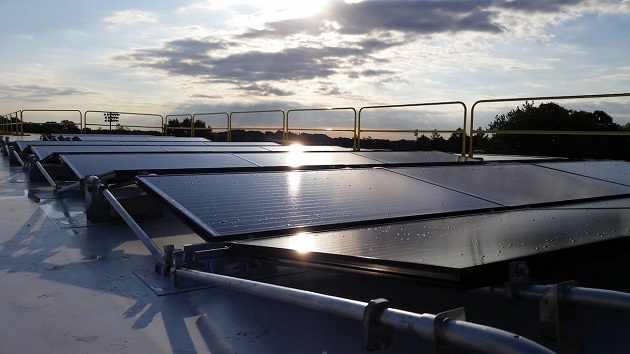
SolarCity says this unique flat-roof system, called ZS Peak, is one of the factors that will drive an increase in its commercial solar business. Photo from SolarCity.
When SolarCity management had its most recent earnings call, in February, there was a lot of disappointment about deployments in the commercial sector. The company built just 28 megawatts in the final quarter of 2014, less than it had in the same quarter in 2013. On an annual basis, commercial went from 75 out of 259 MW total in 2013, to 78 of 503 MW in 2014.
But CEO Lyndon Rive brushed aside suggestions that commercial was a fading business for the nation’s leading solar installer, declaring, “We are doubling down on the growth of commercial.”
Today, the company put some oomph behind that claim, announcing a new $1 billion fund, backed by longtime partner-in-residential-solar Credit Suisse, “that is expected to finance more than 300 megawatts of new commercial solar projects over the next two years.”
That would represent huge gains for SolarCity, and a nice boost for a broader commercial sector that has been a bit of a solar party pooper of late. As the most recent SEIA/GTM Research industry update noted:
While residential solar has soared in the U.S., commercial solar has stagnated. In 2014, just over 1,000 MWdc of commercial solar capacity was installed, down 6% from 2013 and even down 3 percent from 2012. Many factors have contributed to this trend, ranging from tight economics to difficulty financing small commercial installations.
The financing challenge has long been identified as a hurdle for commercial solar in moving beyond big, obvious targets like the Walmarts, Costcos and Apples of the world. Michael Mendelsohn, who studies solar finance issues for the National Renewable Energy Laboratory, said a large part of the problem is the lack of a widely accepted way for investors to assess a customer’s payment risk. In the residential market, FICO scores readily serve that purpose, but there’s nothing comparable for small and medium-sized companies that, in the aggregate, have tons of commercial roof space sitting empty.
Mendelsohn said there are other factors at play as well, but the financing issue alone can translate to increased complication and cost that can be problematic in the commercial solar space.
SolarCity’s VP of communications, Jonathan Bass, said a fund like the one SolarCity announced today gives the company flexibility to take on the challenge.
“The way a lot of developers approach commercial solar is, they’ll have a single project that they’ll bid on, and then if they win the bid they’ll go out and try to get financing,” Bass said. “With a large fund, you have the ability to finance a diverse array of projects.”
SolarCity’s 300-MW two-year number is big, but there have been other signs that commercial is likely to pick up the pace. As U.S. law now stands, the federal investment tax credit for solar will drop from 30 percent to 10 percent at the end of next year, and that should spur potential customers to get in now, while the getting’s good.
Also, this year has seen the independent energy company Tenaska take a controlling interest in commercial and industrial solar developer Soltage – which focuses on projects in the 1-30 MW range – “with an expectation to deploy more than $250 million for roughly 125 MW of solar projects through 2015 and 2016.”
Similarly, Duke Energy took a majority stake in REC Solar, which had sold off its residential unit to Sunrun in early 2014 and was focused on the commercial sector.
GTM Research recently forecast a 40 percent gain in new commercial installations in 2015 over last year.
SolarCity is claiming some unique advantages that can help it grab a big chunk of the growth while also earning a reasonable margin (margins for commercial have always been lower than for residential). First, it cites its DemandLogic system, which combines batteries and energy management software to trim peak demand. SolarCity says that with a lot of commercial customers paying some part of their electricity bill based on peak use, this can be a big benefit. The company also points to its ZS Peak flat-roof mounting system, which it says makes installations less expensive, more productive and far faster to complete.
ZS Peak was introduced last September and DemandLogic was introduced in December 2013. They obviously didn’t do much to move the needle on SolarCity’s commercial business last year. Bass said that was to be expected, given that commercial projects can take a while to come to fruition, and that their full impact would soon begin to show up in the company’s results.
